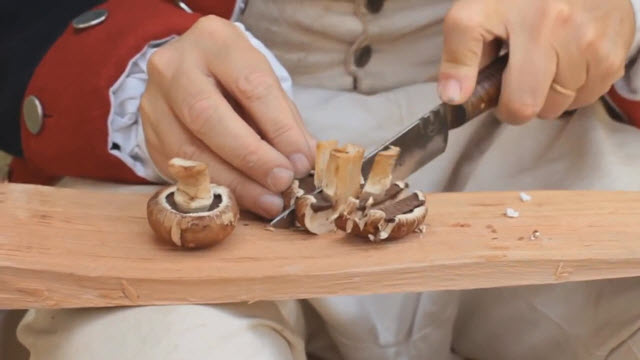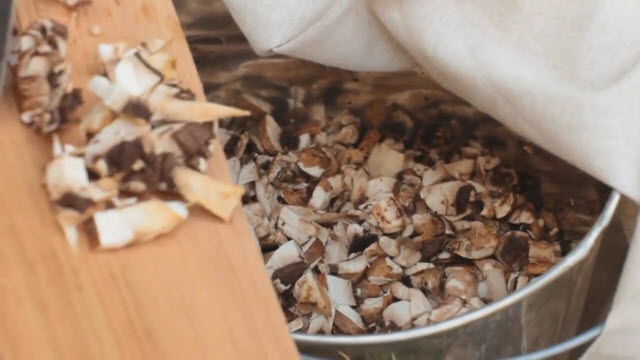
The first recipe for tomato ketchup was in 1801, but tomato ketchup did not become popular until the mid-19th century. The tomato plant is a member of the deadly nightshade family and many people considered it a deadly poison in the 18th century. Today we’re going to make an 18th century ketchup recipe with mushrooms. This would be a seasoning or a flavor that 18th century soldiers would be very familiar with.
- 2 Pounds Fresh Common Brown Mushrooms
- Couple spoonfuls of Salt
- Couple of Bay leaves
- 1 Chopped Onion
- Zest of 1 lemon
- 1 Tablespoon finely grated Horse Radish
- ¼ teaspoon Cloves
- Pinch of Cayenne
- ½ teaspoon Allspice
- ¼-½ cup Cider Vinegar

We’re starting off with 2 pounds of fresh mushrooms, but first a word of warning. We’re using common brown mushrooms in our recipe today. 
These mushrooms are native throughout Europe and North America, but even common mushrooms can easily be mistaken for poisonous or even deadly varieties, so make sure to use something you know is completely safe.

We need to gently wipe these mushrooms off. We don’t want to rinse them off or wash them, because that added liquid would dilute our final flavors. Chop them into small pieces.

Put the mushrooms in a container that can sit overnight and add a couple spoonfuls of salt to draw the juices out. In addition to that salt, we’re going to add a couple of bay leaves. We’re going to mash it up and smoosh these mushrooms down, then we’re going to cover it and then let it set for about 10 minutes.

After 10 minutes check on your mushrooms to make sure they’ve already started reducing. Cover and set aside overnight in a safe place.

Once the mushrooms have completely soaked, add in 1 chopped up onion, the zest of 1 lemon and 1 tablespoon of finely grated horse radish.  We’re going to use a ¼ teaspoon of cloves, a pinch of cayenne and about ½ teaspoon allspice.
We’re going to use a ¼ teaspoon of cloves, a pinch of cayenne and about ½ teaspoon allspice.
The last ingredient we need is a ¼ – ½ cup of cider vinegar. We’re going to stir up all these things together and then put it over the fire and let it simmer for about 15 minutes. 
Once it is done simmering allow it to cool a bit. 
Once cool enough pour it through a squeeze cloth into another container and squeeze all the liquid out.

You can save both the liquid, but also the leftover dried mushrooms. You can use the dried mushrooms as is or grind it up to flavor other recipes.
There are some amazing complex flavors in this. You get the salt first, then some of the other spices, and the earthiness of the mushrooms. Some very complex and wonderful flavors.
Transcript of Video:
Many different 18th century recipes and a lot of writings refer to something called ketchup. Now ketchup in the 18th century wasn’t so much like this as it is more like this.
The word ketchup finds its roots in 17th century China. The Chinese had a similar sounding name for a concoction that consisted of pickled fish and spices. The British traders found this seasoning to be delightful. They brought it home and it quickly became the staple of the English and American diet.
Today we’re going to make an 18th century ketchup recipe with mushrooms. This would be a seasoning or a flavor that 18th century soldiers would be very familiar with.
James Townsend and Son carries all the equipment we’ll be using today and you can find each one of these things in our catalog or on our website. We’re starting off with 2 pounds of fresh mushrooms, but first a word of warning. We’re using common brown mushrooms in our recipe today. These mushrooms are native throughout Europe and North America but even common mushrooms can easily be mistaken for poisonous or even deadly varieties, so make sure to use something you know is completely safe.
With our mushrooms, we need to gently wipe these mushrooms off. We don’t want to rinse them off or wash them because that added liquid would dilute our final flavors.
And we’re going to add these to our tin cooking pot. We need to draw the juices out of our chopped up mushrooms. The best way to do that is to add a couple spoonfuls of salt. In addition to that salt, we’re going to add a couple of bay leaves. We’re going to mash it up, smoosh these mushrooms down in and then we’re going to cover it and then let it set for about 10 minutes.
We’ve let these set 10 minutes and they’ve already started reducing. The liquids being drawn out of the mushrooms and it’s already reduced in size a little bit. I’m going to transfer these into a milk pan here and then we can let this sit overnight.
I’m going to put this pie pan on top just to keep the critters out.
The first recipe for tomato ketchup was in 1801, but tomato ketchup did not become popular until the mid-19th century. The tomato plant is a member of the deadly nightshade family and many people considered it a deadly poison in the 18th century.
Well, let’s take a look.
There we have it. The mushrooms have completely soaked and now it’s time for the next step.
So now it’s time to add in 1 chopped up onion, the zest of 1 lemon and 1 tablespoon of finely grated horse radish. James Townsend and Son offers a pocket spice kit. It comes with salt and pepper, cinnamon, cayenne and thyme. It also comes with an empty vial and in that vial I’ve added cloves. In the recipe here, we’re going to use a quarter teaspoon of cloves. We’re going to use a pinch of cayenne and some allspice also, about a half a teaspoon.
And the last ingredient we need is a quarter to a half a cup of cider vinegar. We’re going to stir up all these things together and then we’re going to put this over the fire and let it simmer for about 15 minutes.
Joseph Plumb Martin’s book, sometimes called Private Yankee Doodle, many times it mentions when he’s eating, that they’re lacking sauce for their meat. More than likely this is what he was craving.
This is done simmering now. I’ve let it cool a little bit but now it’s time to pour it off and I’ve got our milk pan and I’ve got a squeeze cloth here. I’m going to pour this in here to let it cool.
Once this is cooled off, we’re going to take that cloth and bundle it up and squeeze all the liquid out.
There’re some amazing complex flavors in this. You get the salt first, then some of the other spices, the earthiness of the mushrooms, very complex, very wonderful flavor. We’re going to cork this up. We’re going to bottle it, cork it, and save it for our future recipes. So when you’re done with squeezing out the mushrooms, you don’t want to get rid of that. You don’t want to throw that out. That is especially good stuff. You dry that and you can either leave it like it is or you can grind it up. Some of this stuff you can sprinkle it almost like salt. It is really, really good stuff.
And there we have it, our ketchup. Our 2 pounds of mushrooms worked out to be a little over a pint of liquid ketchup. We also have our leftover dried mushrooms. Those are going to be great for future recipes. All the equipment that you saw here, all the utensils, it’s available on our website, in our print catalog, and don’t forget to follow us on Facebook.


Can you use button mushrooms (white, champignons) or Portobello mushrooms instead of common brown mushrooms?
Wow, I’m not sure how I missed your question. I’m sorry for the delay in my response. Yes, you can use any edible mushroom you wish for this.